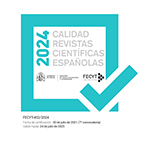Proposte
Lista di controllo per la predisposizione di una proposta
Durante la procedura di trasmissione di una proposta, gli autori devono verificare il rispetto dei seguenti requisiti; la submission potrebbe essere rifiutata se non aderisce a queste richieste.Informativa sui diritti
La revista Cuadernos de Filología Clásica. Estudios griegos e indoeuropeos, para fomentar el intercambio global del conocimiento, facilita el acceso sin restricciones a sus contenidos desde el momento de su publicación en la presente edición electrónica, y por eso es una revista de acceso abierto. Los originales publicados en esta revista son propiedad de la Universidad Complutense de Madrid y es obligatorio citar su procedencia en cualquier reproducción total o parcial. Todos los contenidos se distribuyen bajo una licencia de uso y distribución Creative Commons Reconocimiento 4.0 (CC BY 4.0). Esta circunstancia ha de hacerse constar expresamente de esta forma cuando sea necesario. Puede consultar la versión informativa y el texto legal de la licencia.
Informativa sulla privacy
Información básica sobre la actividad de tratamiento: Servicio de Publicaciones
| Responsable | Vicerrectorado de Cultura, Deporte y Extensión Universitaria +info |
| Finalidad | Divulgación, venta, facturación y envío de publicaciones +info |
| Legitimación | Misión en interés público; ejecución de contrato +info |
| Destinatarios | No se cederán datos a terceros, salvo obligación legal +info |
| Derechos | Acceder, rectificar y suprimir los datos, así como otros derechos, explicados en la información adicional +info |
| Información adicional |
Puede consultarla con detalle en nuestra página web: |









